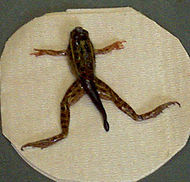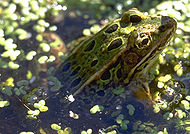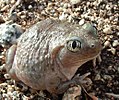Template:Otheruses Template:Taxobox
Frog is the common name for amphibians in the order Anura. Adult frogs are characterised by long hind legs, a short body, webbed digits, protruding eyes and the absence of a tail. A distinction is often made between frogs and toads based on appearance, but this has no taxonomic basis and is a case of convergent adaptation of so-called toads to dry environments. The only family exclusively given the common name "toad" is Bufonidae, but many species from various other families are also called "toads". "True frogs" are of the family Ranidae.
Most frogs have a semi-aquatic lifestyle, and their larvae, called tadpoles, have gills and develop in water. Adult frogs follow a carnivorous diet, mostly composed of arthropods, annelids and gastropods. Frogs are most noticeable through their call, which can be widely heard during the mating season. The distribution of frogs ranges from tropic to subarctic regions, with most of the species found in tropical rainforests.
Morphology and physiology
The morphology of frogs is unique among amphibians. Compared with the other two groups of amphibians (salamanders and caecilians), frogs are unusual because they lack tails as adults and their legs are more suited to jumping than walking. The physiology of frogs is generally like that of other amphibians (and differs from other terrestrial vertebrates) because oxygen may pass through their highly permeable skin. This unique skin allows frogs to "breathe" largely through their skin. Because the oxygen is dissolved in an aqueous film on the skin and passed from there to the blood, this also requires that the skin stay moist at all times, and makes frogs susceptible to many toxins in the environment, some of which can similarly dissolve in the layer of water and be passed on to the blood (also see Decline in frog populations).
Body plan
Because of the great diversity of frogs (approximately 5,250 described species), many characteristics are not shared by all of the species. However, there are some general characteristics that distinguish them from other amphibians. Frogs are usually well suited to jumping and have long hind legs with elongated ankle bones. They have a short vertebral column, with no more than ten free vertebrae, followed by a fused tail bone (urostyle or coccyx), normally resulting in a tailless frog.
Frogs range in size from 10 mm (Psyllophryne didactyla of Brazil and Eleutherodactylus iberia of Cuba) to 300 mm (Goliath frog, Conraua goliath, of Cameroon).
The skin hangs loosely on the body because of the lack of loose connective tissue. Skin texture varies: it can be smooth, warty or folded. Frogs have three eyelid membranes: one is transparent to protect the eyes underwater, while the two others vary from translucent to opaque. They have a tympanum on each side of the head, which is involved in hearing, and is covered by skin in some species.
Feet and legs
The structure of the feet and legs varies greatly among different species of frog, depending in part on whether it lives primarily on the ground, in water, or in trees. Frogs must be able to move quickly through their environment to catch prey and escape predators, and diverse adaptations help them do so.
Many frogs, especially those that live in water, have webbed toes. The degree to which the toes are webbed is directly proportional to the amount of time the species lives in the water. For example, the completely aquatic African dwarf frog (Hymenochirus sp.) has fully webbed toes, whereas the toes of White's tree frog, an arboreal species, are only half or one-quarter webbed.
Arboreal frogs have "toe pads" to help grip vertical surfaces. These pads, located on the ends of the toes, do not work by suction. Rather, the surface of the pad consists of interlocking cells, with a small gap in between each cell. When the frog applies pressure to the toe pads, the interlocking cells grip irregularities on the substrate. The small gaps between the cells also drain away all but a thin layer of moisture on the pad, and maintain a grip through capillarity. This allows the frog to grip smooth surfaces, and does not function when the pads are excessively wet. [1]
In many arboreal frogs, a small "intercalary structure" in each toe increases the surface area touching the substrate. Furthermore, since hopping through trees can be dangerous, many arboreal frogs have hip joints that allow both hopping and walking. Finally, some frogs that live high in trees even possess an elaborate degree of webbing between their toes, as in aquatic frogs. But in these arboreal frogs, the webs allow the frogs to "parachute" or control their glide from one position in the canopy to another. [2]
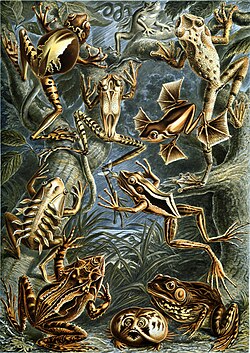
Ground-dwelling frogs generally lack the adaptations of aquatic and arboreal frogs. Most have reduced toe pads, if any, and little webbing. Some burrowing frogs possess a toe extension called a metatarsal tubercle, and this structure helps them burrow. Also, the hind legs of ground dwellers are more muscular than those of either aqueous or tree-dwelling frogs.
Moisture retention
Many frogs are able to absorb water directly through the skin, especially around the pelvic area. However, the permeability of a frog's skin can also result in water loss. Some tree frogs reduce water loss with a waterproof layer of skin. Others have adapted behaviours that conserve water, including engaging in nocturnal activity and resting in a water-conserving position. This position involves the frog lying with its toes and fingers tucked under its body and chin, respectively, with no gap between the body and substrate. These adaptations only reduce water loss enough for a predominately arboreal existence, and are not suitable for arid conditions.
Frogs that live in arid areas such as deserts, where water may not be easily accessible, must rely on other adaptations. The Australian genus Cyclorana and the American genus Pternohyla will dig underground, create a water-impervious cocoon and hibernate during dry periods. Once it rains, they emerge, find a temporary pond and breed. Egg and tadpole development is very fast in comparison to most other frogs so that breeding is complete before the pond dries up.
Respiration and circulation
Just as frogs are able to absorb water through their skin, they are also able to breathe through their skin. There are a number of blood vessels near the surface of the skin. When a frog is underwater, oxygen is transmitted through the skin directly into the bloodstream. On land, adult frogs use their lungs to breathe. Their lungs are similar to those of humans, but the chest muscles are not involved in respiration, and there are no ribs or diaphragm to support breathing. Frogs can breathe by simply opening the mouth and letting air flow into the trachea. They can also breathe with their mouths closed by taking air in through the nostrils (causing the throat to puff out), and then compressing the floor of the mouth, which forces the air into the lungs.
The frog is also known for its three-chambered heart, in which oxygenated blood from the lungs and deoxygenated blood from the respiring tissues enters by separate atria, and is directed to the appropriate vessel (aorta for oxygenated and pulmonary vein for deoxygenated blood) by the spiral valve. This special structure is essential to keeping the mixing of the two types of blood to a minimum, and this in turn enables frogs to have higher metabolic rates, and be more active than otherwise.
Poison

Many frogs contain mild toxins that make them distasteful to potential predators. For example, all toads have large poison glands (called the parotoid glands) located behind the eyes on the top of the head. Some frogs, such as some Poison Dart Frogs, are especially toxic. The chemical makeup of toxins found in frogs varies from irritants to hallucinogens, convulsants, nerve poisons, and vasoconstrictors (which act to narrow the blood vessels). Many predators of frogs have adapted to tolerate high levels of these poisons. Others, including humans, may be severely affected and hence deterred by them.
In some cases frogs obtain poisons from the ants and other arthropods they eat, [3] although others, such as the Australian Corroboree Frogs (Pseudophryne corroboree and Pseudophryne pengilleyi), can manufacture an alkaloid not derived from their diet [4]. Some native people of South America extract poison from the poison dart frogs and put it on their darts when hunting [5], though few species are toxic enough to be used for this purpose. It was previously a misconception that the poison was placed on arrows rather than darts. The common name of these frogs was thus changed from "Poison Arrow Frog" to "Poison Dart Frog" in the early 1980s. Poisonous frogs tend to advertise their toxicity with bright colours, an adaptive strategy known as aposematism. There are also at least two non-poisonous species of frogs in tropical America (Eleutherodactylus gaigei and Lithodytes lineatus) which mimic dart poison frogs' coloration to protect themselves. [6][7]
Because frog toxins are so extraordinarily diverse, they have raised interest of biochemists as a "natural pharmacy". The alkaloid epibatidine, a painkiller 200 times more potent than morphine, is found in some species of poison dart frogs. Other chemicals isolated from the skin of frogs may offer resistance to HIV infection[8].
Natural history
The life cycle of frogs, like other amphibians, consists of four main stages: egg, tadpole, metamorphosis, and adult. The reliance of frogs on an aquatic environment for the egg and tadpole stages gives rise to a variety of breeding behaviours that include the well-known mating calls used by males of most species to attract females to water bodies. Some frogs also look after their eggs and even in some cases tadpoles for some time after laying.
From eggs to adults
The life cycle of a frog starts with an egg. Eggs are generally laid in water, and an individual female may lay egg masses containing thousands of eggs. The eggs, however, are highly vulnerable to predation. Frogs have evolved many techniques to ensure the survival of the next generation. Most commonly, this involves synchronous reproduction. Many individuals will breed at the same time, overwhelming predators. The majority of the offspring will still die due to predation, but there is a greater chance some will survive than a laying of smaller numbers. Another way in which some species avoid the predation and pathogens eggs are exposed to in ponds is to lay eggs on leaves above the pond, with a gelatinous coating designed to retain moisture. In these species the tadpoles drop into the water upon hatching. In some species eggs laid out of water can detect vibrations of predaceous wasps or snakes approaching the eggs, and will hatch early to avoid being eaten. [9] Some species, such as the Cane Toad (Bufo marinus), also possess poisonous eggs which prevent predation. While the length of the egg stage depends on the species and environmental conditions, aquatic eggs generally hatch within one week.
Eggs hatch and continue life as tadpoles (occasionally known as polliwogs). Tadpoles are aquatic, lack front or hind legs, have gills for respiration and tails with fins for swimming. Tadpoles are typically herbivorous, feeding mostly on algae, including diatoms that are filtered from the water through the gills. Some species are carnivorous at the tadpole stage, eating insects, smaller tadpoles or fish. Tadpoles are highly vulnerable to predation by fish, newts, predatory diving beetles, and birds such as kingfishers. Cannibalism has also been observed among tadpoles. Poisonous tadpoles are present in many species, such as Cane Toads. The tadpole stage may be as short as a week, or tadpoles may overwinter and metamorphosis the following year in some species, such as the Midwife toad (Alytes obstetricans) and the Common Spadefoot (Pelobates fuscus).
At the end of the tadpole stage, frogs undergo metamorphosis, in which they transition into adult form. Metamorphosis involves a dramatic transformation of morphology and physiology, as tadpoles develop hind legs and then front legs, lose their gills, and develop lungs. Their intestines shorten as they shift from an herbivorous to a carnivorous diet. The final stage of development from froglet to adult frog involves apoptosis (programmed cell death) of the tail.
After metamorphosis young adults may leave the water and disperse into terrestrial habitats, or continue to live in the aquatic habitat as adults. Almost all species of frogs are carnivores as adults, eating invertebrates such as arthropods, annelids and gastropods. A few of the larger species may eat prey such as small mammals, fish and smaller frogs. Some frogs use their sticky tongues to catch fast-moving prey, while others capture their prey and force it into their mouths with their hands. However, there are a very few species of frogs which primarily eat plants[10]. Adult frogs are themselves predated by birds, large fish, snakes, otters, foxes, badgers, coatis, and other animals. Frogs are also eaten by people (see section on agriculture, below).
Reproduction
Once adult frogs reach maturity, they will assemble at a water source such as a pond or stream to breed. The male frogs will then call to attract a mate, collectively becoming a chorus of frogs. The call is unique to the species, and will attract females of that species. Some species have satellite males who do not call but intercept females approaching one of the calling males.
The male and female frog will then undergo amplexus. This involves the male mounting the female and gripping her tightly. Fertilization is external: the egg and sperm meet outside of the body. The female releases her eggs, which the male frog covers with a sperm solution. The eggs will then swell and develop a protective coating. The eggs are typically brown or black, with a clear, gelatin-like covering.
Most temperate species of frogs reproduce in the period between late autumn to early spring. In the UK, most common frog populations produce frogspawn in February, although there is wide variation in timing. Water temperatures at this time of year are relatively low, typically between four and 10 degrees Celsius. Reproducing in these conditions helps the developing tadpoles because dissolved oxygen concentrations in the water are highest at cold temperatures. More importantly, reproducing early in the season ensures that appropriate food is available to the developing frogs at the right time.
Parental care
Although care of offspring is poorly understood in frogs, it is estimated that up to 20% of amphibian species may care for their young in one way or another, and there is a great diversity of parental behaviours [11]. Some species of poison dart frog will lay eggs on the forest floor and protect them until hatching. This protection involves guarding the eggs from predation and keeping the eggs moist. The frog will urinate on them if they become too dry. After hatching, a parent (the gender depends upon the species) will move them, on its back, to a water-holding bromeliad. The parent will then feed them through laying unfertilised eggs into the bromeliad until the young have metamorphosed. Other frogs will carry the eggs and tadpoles on their hind legs or back (e.g. the midwife toads, Alytes spp.). Some frogs even protect their offspring inside their own body. The male Australian pouched frog (Assa darlingtoni) has pouches along its side in which the tadpoles will reside until metamorphosis. The female Gastric-brooding Frogs (genus Rheobatrachus) from Australia swallows its tadpoles which develop in the stomach. To do this, the Gastric-brooding Frog must stop secreting stomach acid and suppress peristalsis (contractions of the stomach). Darwin's Frog (Rhinoderma darwinii) from Chile puts the tadpoles in its vocal sac for development.
Call
The call of a frog is unique to its species. Frogs call by passing air through the larynx in the throat. In most calling frogs, the sound is amplified by the vocal sac(s), a membrane of skin under the throat or on the corner of the mouth which distends during the amplification of the call.
Some frogs lack vocal sacs, such as those from the genera Heleioporus and Neobatrachus, but even these can still produce a loud call. Their buccal cavity is enlarged and dome shaped, acting as a resonance chamber that amplifies their call. Species of frog which do not have vocal sacs and do not have a loud call tend to inhabit areas close to flowing water. The noise of flowing water overpowers any call, so they must communicate by other means.
The main reason for calling is to allow the male to attract a mate. Males call either individually or in a group called a "chorus". Females of many frog species, for example Polypedates leucomystax, produce calls reciprocal to the males' which act as the catalyst for the enhancement of reproductive activity in the breeding colony (Roy, 1997). A male frog will emit a release call when mounted by another male. Tropical species also have a rain call which is made based on humidity cues prior to a rain shower. Many species also have a territorial call that is used to chase away other males. All of these calls are emitted with the mouth of the frog closed.
A distress call, emitted by some frogs when they are in danger, is produced with the mouth open, resulting in a higher-pitched call. The effectiveness of the call is unknown; however, it is suspected the call intrigues the predator until another animal is attracted, distracting them enough for its escape.
Many species of frog have deep calls, or croaks. The onomatopoeic spelling (for English speakers) is often "crrrrk" in Britain and "ribbit" in the U.S. This difference is due to the different species within each region (e.g. Common frog (Rana temporaria) in Britain and Leopard frog (Rana pipiens) in the U.S.). The croak of the American bullfrog (Rana catesbiana) is sometimes spelt "jug o' rum".
Camouflage
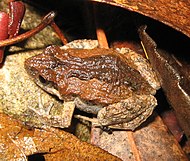
Camouflage is a common defensive mechanism in frogs. Most camouflaged frogs are nocturnal, which adds to their ability to hide. Nocturnal frogs will usually find the ideal camouflaged position during the day to sleep. Some frogs have the ability to change colour. However, this is usually restricted to shades of one or two colours. For example, White's tree frog (Litoria caerulea) varies in shades of green and brown. Features such as warts or skin folds are usually found on ground-dwelling frogs, where a smooth skin would not disguise them effectively. Arboreal frogs usually have smooth skin, enabling them to disguise as leaves.
Certain frogs change colour between night and day, as light and moisture stimulate the pigment cells and cause them to expand or contract.
Distribution and status
Frogs are found nearly worldwide, but they do not occur in Antarctica and are not present on many oceanic islands.
In many parts of the world, frog populations have declined drastically since the 1950s. Many environmental scientists feel that amphibians, and frogs in particular, may be excellent biological indicators of ecosystem function because of their location on the food web, their permeable skins, and their typically biphasic life (in both water and on land).[12] The decline in frog diversity may also be caused by the specialization of particular species on particular kinds of prey, such as certain kinds of earthworms that are themselves indicator species due to their close dependence on soil chemistry.
Although habitat loss is one of the most important causes of frog population decline, pollutants, climate change, introduction of non-indigenous predators/competitors, and infectious diseases (see Chytrid fungus) have also been implicated.
Taxonomy
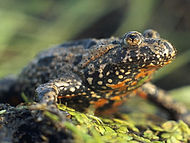
The order Anura contains some 5,250 species in 33 families, whereof the Leptodactylidae (1100 spp.), Hylidae (800 spp.) and Ranidae (750 spp.) are the most speciose. More than 80% of amphibian species are frogs.
The use of the common names "frog" and "toad" has no real taxonomic justification. From a taxonomic perspective, all members of the order Anura are frogs, but only members of the family Bufonidae are considered "true toads". The use of the term "frog" in common names usually refers to species which are aquatic or semi-aquatic with smooth or moist skins, and the use of the term "toad" generally refers to species that tend to be terrestrial with dry, warty skin. An exception can be made for the Fire-bellied toad (Bombina bombina); while its skin is slightly warty, it prefers a watery habitat.
Frogs and toads are broadly classified into three suborders: Archaeobatrachia (which includes four families of primitive frogs), Mesobatrachia (which includes five families of more evolutionary intermediate frogs), and Neobatrachia (by far the largest group which contains the remaining 24 families of "modern" frogs, including most common species throughout the world). The Neobatrachia is further divided into the Hyloidea and Ranoidea [13]. This classification is based upon such morphological features as number of vertebrae, structure of the pectoral girdle, and morphology of tadpoles. While this classification is largely accepted, relationships among families of frogs are still largely debated. Future studies of molecular genetics should soon provide further insights to evolutionary relationships among frog families [14].
Some species of anurans hybridise readily. For instance, the Edible Frog (Rana esculenta) is a hybrid of the Pool Frog (R. lessonae) and the Marsh Frog (R. ridibunda). Bombina bombina and Bombina variegata similarly form hybrids, although these are less fertile, giving rise to a hybrid zone.
Evolution
The earliest amphibian discovered to date is Elginerpeton, found in Late Devonian rocks of Scotland dating to approximately 368 million years ago. The earliest well-known amphibian, Ichthyostega, was found in Late Devonian deposits in Greenland, dating back about 363 million years. The later Paleozoic saw a great diversity of amphibians, ranging from small, legless swimming forms (Aïstopoda) to bizarre "horned" forms (Nectridea). These first amphibians are thought to have evolved from bony fish of the class Osteichthyes, which were widespread during the period that amphibia emerged. There is, however, substantial debate over what type of bony fish was the precursor to amphibians. Suggestions include the lungfish and the Actinopterygii as the forerunners to modern amphibia.
The earliest known (proto)frog is †Triadobatrachus massinoti, from the early Triassic of Madagascar. It is about 250 million years old, and had not yet evolved the full combination of features currently associated with frogs. The skull is frog-like, being broad with large eye sockets, but the fossil has a number of other features diverging from modern amphibia. These include a different ilium, a longer body with more vertebrae, and separate vertebrae in its tail (whereas in modern frogs, the tail vertebrae are fused, and known as the urostyle or coccyx). The tibia and fibula bones are unfused and separate, making it probable that Triadobatrachus was not a very efficient leaper.
Another fossil frog, discovered in Arizona and called †Prosalirus bitis, was uncovered in 1985, and dates from roughly the same time as Triadobatrachus. Like Triadobatrachus, Prosalirus did not have greatly enlarged legs, but possessed the typical three-pronged pelvic structure. Unlike Triadobatrachus, Prosalirus had already lost nearly all of its tail.
The earliest true frog is †Vieraella herbsti, from the early Jurassic (188–213 mya). It is known only from the dorsal and ventral impressions of a single animal and was estimated to be 33 mm in snout-vent length. †Notobatrachus degiustoi from the middle Jurassic is just a bit younger, about 155–170 million years old. It seems likely that the evolution of modern anura was completed by the Jurassic period. The main evolutionary changes involved shortening of the body and loss of the tail.
Frog fossils have been found on all continents, including Antarctica.
Uses in agriculture and research
Frogs are raised commercially for several purposes. Dead frogs are sometimes used for dissections in high school and university anatomy classes, often after being injected with coloured plastics to enhance the contrast between different organs. This use has declined in recent years with an increased awareness of animal rights issues. Frogs are also used as a food source, with frog legs being a delicacy in China, France, and in many parts of the American South, especially Louisiana. The French custom of eating frog legs is the source of the English use of the derogatory nickname "frogs" for French people.
The African clawed frog, Xenopus laevis, has been used as an important model organism in developmental biology for a long time due to its large and easily manipulable embryo. The genome project of its close and faster-maturing relative, Xenopus tropicalis, will likely be completed by 2015, possibly sooner[15].
Gallery
Eastern Banjo Frog (Limnodynastes
dumerili)Red-eyed Tree Frog (Agalychnis callidryas)
Marsh Frog (Rana ridibunda)
Painted Frog (Discoglossus galganoi)
Common Parsley Frog (Pelodytes punctatus)
Edible Frog (Rana esculenta)
Stoney Creek Frog (Litoria wilcoxi)
Purple Frog (Nasikabatrachus sahyadrensis)
Golden toad (Bufo periglenes)
Black and yellow poison frog (Dendrobates leucomelas)
Sheep Frog (Hypopachus variolosus)
Western spadefoot toad (Spea hammondii)
See also
Notes and references
- ^ Emerson, S.B. and Diehl, D. 1980. Toe pad morphology and mechanisms of sticking in frogs. Biol. J. Linn. Soc. 13(3): 199-216.
- ^ Harvey M. B, A. J. Pemberton, and E. N. Smith. 2002. New and poorly known parachuting frogs (Rhacophoridae : Rhacophorus) from Sumatra and Java. Herpetological Monographs. 16:46-92.
- ^ Saporito, R.A., H.M. Garraffo, M.A. Donnelly, A.L. Edwards, J.T. Longino, and J.W. Daly. 2004. Formicine ants: An arthropod source for the pumiliotoxin alkaloids of dendrobatid poison frogs. Proceedings of the National Academy of Science 101:8045-8050.
- ^ Smith B. P., Tyler M. J., Kaneko T., Garraffo H. M., Spande T. F., Daly J. W. 2002. "Evidence for biosynthesis of pseudophrynamine alkaloids by an Australian myobatrachid frog (pseudophryne) and for sequestration of dietary pumiliotoxins." J Nat Prod 65(4): 439-47.
- ^ Myers, C.W., and J.W. Daly. 1983. Dart-poison frogs. Scientific American 248:120-133.
- ^ Savage, J. M. 2002. The Amphibians and Reptiles of Costa Rica. University of Chicago Press, Chicago.
- ^ Duellman, W. E. 1978. The Biology of an Equatorial Herpetofauna in Amazonian Ecuador. University of Kansas Museum of Natural History Miscellaneous Publication 65:1-352.
- ^ VanCompernolle, S. E., R. J. Taylor, K. Oswald-Richter, J. Jiang, B. E. Youree, J. H. Bowie, M. J. Tyler, M. Conlon, D. Wade, C. Aiken, and T. S. Dermody. 2005. Antimicrobial peptides from amphibian skin potently inhibit Human Immunodeficiency Virus infection and transfer of virus from dendritic cells to T cells. Journal of Virology 79:11598-11606.
- ^ Warkentin, K.M. 1995. Adaptive plasticity in hatching age: a response to predation risk trade-offs. Proceedings of the National Academy of Sciences 92:3507-3510.
- ^ Silva H. R., Britto-Pereira M. C., & Caramaschi U. (1989). Frugivory and Seed Dispersal by Hyla truncata, a Neotropical Treefrog. Copeia 1989(3):781–783.
- ^ Crump, M.L. 1996. Parental care among the Amphibia. Advances in the Study of Behavior 25:109-144.
- ^ Phillips, Kathryn. Tracking the Vanishing Frogs. New York: Penguin Books. 1994. ISBN 0140246460
- ^ Ford, L.S. and D.C. Cannatella. 1993. The major clades of frogs. Herpetological Monographs 7:94-117.
- ^ Faivovich, J., C.F.B. Haddad, P.C.A. Garcia, D.R. Frost, J.A. Campbell, and W.C. Wheeler. Systematic review of the frog family Hylidae, with special reference to Hylinae: Phylogenetic analysis and taxonomic revision. Bulletin of the American Museum of Natural History 294:1-240.
- ^ "Joint Genome Institute - Xenopus tropicalis Home". http://genome.jgi-psf.org/Xentr4/Xentr4.home.html. Retrieved 2006-03-03.
- Cogger, H.G., R.G. Zweifel, and D. Kirschner. (2004). Encyclopedia of Reptiles & Amphibians Second Edition. Fog City Press. ISBN 1877019690.
- Estes, R., and O. A. Reig. (1973). "The early fossil record of frogs: a review of the evidence." pp. 11-63 In J. L. Vial (Ed.), Evolutionary Biology of the Anurans: Contemporary Research on Major Problems. University of Missouri Press, Columbia.
- Holman, J. A. (2004). Fossil Frogs and Toads of North America, Indiana University Press. ISBN 0253342805.
- Roy, Debjani. (1997) Communication signals and sexual selection in amphibians. Current Science 72, 923-927.
- Tyler, M. J. (1994). Australian Frogs A Natural History. Reed Books ISBN 0730104680.
External links
Template:Commons Template:Cookbook
- The Whole Frog Project - Virtual frog dissection and anatomy
- Disappearance of toads, frogs has some scientists worried - San Francisco Chronicle, April 20, 1992
- Xenbase - A Xenopus laevis and tropicalis Web Resource
- Tree of Life (Salientia)
- Amphibia Web
- Time-lapse video showing the egg's development until hatching
- Whole Frog Quicktime video of frog anatomy
- Try an on-line "virtual frog dissection" here.
- Frog calls - short video clips of calling frogs and interviews with scientists about frog issues, including declining and malformed frog causes
- Dart Den - Dart frog resource and forums
- Record UK Frogspawn sightings here - Springwatch 2006
- Frogwatch USA volunteer frog and toad monitoring program by National Wildlife Federation and USGS, includes links to frog calls of the United States
- Amphibian photo gallery by scientific name - features many unusual frogs
ar:ضفدع ast:Xaronca bg:Безопашати земноводни ca:Granota cs:Žáby cy:Llyffant da:Frø (padde) de:Froschlurche eo:Rano es:Rana fr:Grenouille he:צפרדע ja:カエル ku:Beq li:Kwakkers ms:katak nl:Kikker no:Frosk pl:żaba pt:Rã sh:Žaba simple:frog sr:Жаба sv:Grodor

